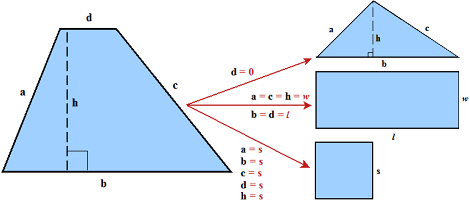the two trapezoid formulas yield the following:
| P = | h + h + h + h | & | A = | 0.5(h + h) × h |
| = | 4h | = | 0.5(2h) × h | |
| = | 1h × h | |||
| = | h² |
| P = | 4s | & | A = | s² |
|
to put in short or concise form; to reduce in volume; to epitomize something by expressing it as a brief summary |
|---|
Mission accomplished? The splendid details of all these foregoing derivations are secondary in importance to recognizing that the triangle, rectangle, and square are all transformations of the more general figure — the (totally terrible and terrifying) trapezoid. Yikes...
In other words, the primary focus is to "realize" that each of the formulas for Perimeter & Area for each of these three polygons are completely contained in the pair of trapezoid formulas:
| P = | a + b + c + d | & | A = | 12(b + d) × h |
|
grasped or understood; to fully get the meaning of |
|---|
|
emotionally or mentally tormenting; extremely painful; tortuous |
|---|
|
to formally compensate or make a financial payment to (for a service provided) |
|---|
